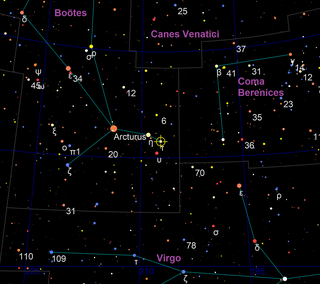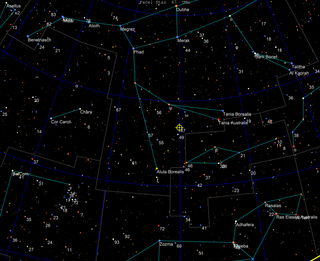Related Research Articles

Upsilon Andromedae is a binary star located 44 light-years from Earth in the constellation of Andromeda. The system consists of an F-type main-sequence star and a smaller red dwarf.

Gamma Cephei is a binary star system approximately 45 light-years away in the northern constellation of Cepheus. The primary is a stellar class K1 orange giant or subgiant star; it has a red dwarf companion. An exoplanet has been confirmed to be orbiting the primary.

Pollux is the brightest star in the constellation of Gemini. It has the Bayer designation β Geminorum, which is Latinised to Beta Geminorum and abbreviated Beta Gem or β Gem. This is an orange-hued, evolved red giant located at a distance of 34 light-years, making it the closest red giant to the Sun. Since 1943, the spectrum of this star has served as one of the stable anchor points by which other stars are classified. In 2006 an exoplanet was announced to be orbiting it.
51 Pegasi, formally named Helvetios, is a Sun-like star located 50.6 light-years from Earth in the constellation of Pegasus. It was the first main-sequence star found to have an exoplanet orbiting it.

Tau Boötis, Latinised from τ Boötis, is an F-type main-sequence star approximately 51 light-years away in the constellation of Boötes. It is a binary star system, with the secondary star being a red dwarf. In 1999, an extrasolar planet was detected orbiting the primary star.
Mu Arae, often designated HD 160691, officially named Cervantessur-VAN-teez, is a main sequence G-type star approximately 50 light-years away from the Sun in the constellation of Ara. The star has a planetary system with four known extrasolar planets, three of them with masses comparable with that of Jupiter. Mu Arae c, the innermost, was the first hot Neptune or super-Earth discovered.

55 Cancri is a binary star system located 41 light-years away from the Sun in the zodiac constellation of Cancer. It has the Bayer designation Rho1 Cancri (ρ1 Cancri); 55 Cancri is the Flamsteed designation. The system consists of a K-type star and a smaller red dwarf.

47 Ursae Majoris, formally named Chalawan, is a yellow dwarf star approximately 45.3 light-years from Earth in the constellation of Ursa Major. As of 2011, three extrasolar planets are believed to orbit the star.

Epsilon Tauri or ε Tauri, formally named Ain, is an orange giant star located approximately 146 light-years from the Sun in the constellation of Taurus. An exoplanet is believed to be orbiting the star.

Xi Andromedae, officially named Adhil, is a solitary star in the northern constellation of Andromeda. It has an apparent magnitude of +4.9. Based on parallax measurements obtained during the Gaia mission, it lies at a distance of roughly 223 light-years from the Sun.

Xi Aquilae, officially named Libertas, is a red-clump giant star located at a distance of 186 light-years from the Sun in the equatorial constellation of Aquila. As of 2008, an extrasolar planet has been confirmed in orbit around the star.
Pi1 Cygni (π1 Cygni, abbreviated Pi1 Cyg, π1 Cyg) is a binary star in the northern constellation of Cygnus. It is visible to the naked eye, having a combined apparent visual magnitude of 4.66. The distance to this system can be roughly gauged by its annual parallax shift of 1.89 mas, which yields a separation of around 1,700 light years from the Sun, give or take a hundred light years.
Upsilon Andromedae d, formally named Majriti, is a super-Jupiter exoplanet orbiting within the habitable zone of the Sun-like star Upsilon Andromedae A, approximately 44 light-years away from Earth in the constellation of Andromeda. Its discovery made it the first multiplanetary system to be discovered around a main-sequence star, and the first such system known in a multiple star system. The exoplanet was found by using the radial velocity method, where periodic Doppler shifts of spectral lines of the host star suggest an orbiting object.
HD 104985, formally named Tonatiuh, is a solitary star with a exoplanetary companion in the northern constellation of Camelopardalis. The companion is designated HD 104985 b and named Meztli. This star has an apparent visual magnitude of 5.78 and thus is dimly visible to the naked eye under favorable seeing conditions. It is located at a distance of approximately 329 light years from the Sun based on parallax, but is drifting closer with a radial velocity of −20 km/s.
41 Lyncis, also designated HD 81688 and named Intercrus, is a fifth-magnitude star located in the northern constellation of Ursa Major. An extrasolar planet is thought to be orbiting the star.

14 Andromedae b, formally named Spe, is an exoplanet approximately 249 light years away in the constellation of Andromeda.
81 Ceti is a star located approximately 331 light years away from the Sun in the equatorial constellation of Cetus. 81 Ceti is the Flamsteed designation for this object. It is visible to the naked eye as a dim, yellow-hued point of light with an apparent visual magnitude of 5.65. The star is drifting further away from the Earth with a heliocentric radial velocity of +9 km/s.

42 Draconis, formally named Fafnir, is a 5th magnitude K-type giant star located approximately 295 light years away in the constellation of Draco. As of 2009, an extrasolar planet is thought to be orbiting the star.
HD 32518 is a star with an orbiting exoplanet in the northern circumpolar constellation Camelopardalis. It has an apparent magnitude of 6.42, placing it near the limit of naked eye visibility. Located 397 light years away based on parallax measurements, it is receding with a heliocentric radial velocity of −7.02 km/s.
HD 146389, is a star with a yellow-white hue in the northern constellation of Hercules. The star was given the formal name Irena by the International Astronomical Union in January 2020. It is invisible to the naked eye with an apparent visual magnitude of 9.4 The star is located at a distance of approximately 446 light years from the Sun based on parallax, but is drifting closer with a radial velocity of −9 km/s. The star is known to host one exoplanet, designated WASP-38b or formally named 'Iztok'.
References
- 1 2 3 4 5 6 Vallenari, A.; et al. (Gaia collaboration) (2023). "Gaia Data Release 3. Summary of the content and survey properties". Astronomy and Astrophysics. 674: A1. arXiv: 2208.00211 . Bibcode:2023A&A...674A...1G. doi: 10.1051/0004-6361/202243940 . S2CID 244398875. Gaia DR3 record for this source at VizieR.
- 1 2 3 4 5 6 Anderson, E.; Francis, Ch. (2012), "XHIP: An extended hipparcos compilation", Astronomy Letters, 38 (5): 331, arXiv: 1108.4971 , Bibcode:2012AstL...38..331A, doi:10.1134/S1063773712050015, S2CID 119257644.
- 1 2 Alves, David R. (August 2000), "K-Band Calibration of the Red Clump Luminosity", The Astrophysical Journal, 539 (2): 732–741, arXiv: astro-ph/0003329 , Bibcode:2000ApJ...539..732A, doi:10.1086/309278, S2CID 16673121.
- 1 2 3 4 5 Sato, Bun'ei; et al. (2008). "Planetary Companions to Evolved Intermediate-Mass Stars: 14 Andromedae, 81 Ceti, 6 Lyncis, and HD167042". Publications of the Astronomical Society of Japan. 60 (6): 1317–1326. arXiv: 0807.0268 . Bibcode:2008PASJ...60.1317S. doi:10.1093/pasj/60.6.1317. S2CID 67841762.
- ↑ Samus', N. N; Kazarovets, E. V; Durlevich, O. V; Kireeva, N. N; Pastukhova, E. N (2017), "General catalogue of variable stars: Version GCVS 5.1", Astronomy Reports, 61 (1): 80, Bibcode:2017ARep...61...80S, doi:10.1134/S1063772917010085, S2CID 125853869.
- 1 2 3 4 5 6 7 Ligi, R.; Creevey, O.; Mourard, D.; Crida, A.; Lagrange, A.-M.; Nardetto, N.; Perraut, K.; Schultheis, M.; Tallon-Bosc, I.; Brummelaar, T. ten (2016-02-01), "Radii, masses, and ages of 18 bright stars using interferometry and new estimations of exoplanetary parameters", Astronomy & Astrophysics, 586: A94, arXiv: 1511.03197 , doi:10.1051/0004-6361/201527054, ISSN 0004-6361.
- 1 2 Bonfanti, A.; et al. (2015), "Revising the ages of planet-hosting stars", Astronomy and Astrophysics, 575, A18, arXiv: 1411.4302 , Bibcode:2015A&A...575A..18B, doi:10.1051/0004-6361/201424951, S2CID 54555839.
- 1 2 3 Jofré, E.; Petrucci, R.; Saffe, C.; Saker, L.; de la Villarmois, E. Artur; Chavero, C.; Gómez, M.; Mauas, P. J. D. (2015). "Stellar parameters and chemical abundances of 223 evolved stars with and without planets". Astronomy & Astrophysics. 574: A50. arXiv: 1410.6422 . Bibcode:2015A&A...574A..50J. doi:10.1051/0004-6361/201424474. S2CID 53666931.
- ↑ "14 And". SIMBAD . Centre de données astronomiques de Strasbourg . Retrieved September 19, 2018.
- 1 2 "IAU Catalog of Star Names" . Retrieved 28 July 2016.
- ↑ Eggleton, P. P.; Tokovinin, A. A. (September 2008), "A catalogue of multiplicity among bright stellar systems", Monthly Notices of the Royal Astronomical Society , 389 (2): 869–879, arXiv: 0806.2878 , Bibcode:2008MNRAS.389..869E, doi: 10.1111/j.1365-2966.2008.13596.x , S2CID 14878976.
- ↑ NameExoWorlds: An IAU Worldwide Contest to Name Exoplanets and their Host Stars. IAU.org. 9 July 2014
- ↑ "NameExoWorlds The Process". Archived from the original on 2015-08-15. Retrieved 2015-09-05.
- ↑ Final Results of NameExoWorlds Public Vote Released, International Astronomical Union, 15 December 2015.
- ↑ Thunder Bay Amateur Astronomers Name a Planet
- ↑ "NameExoWorlds The Approved Names". Archived from the original on 2018-02-01. Retrieved 2015-12-16.
- ↑ "IAU Working Group on Star Names (WGSN)" . Retrieved 22 May 2016.
- ↑ "Bulletin of the IAU Working Group on Star Names, No. 1" (PDF). Retrieved 28 July 2016.
- ↑ Ligi, R.; et al. (2012). "A new interferometric study of four exoplanet host stars : θ Cygni, 14 Andromedae, υ Andromedae and 42 Draconis". Astronomy and Astrophysics. 545. A5. arXiv: 1208.3895 . Bibcode:2012A&A...545A...5L. doi:10.1051/0004-6361/201219467. S2CID 10934982.